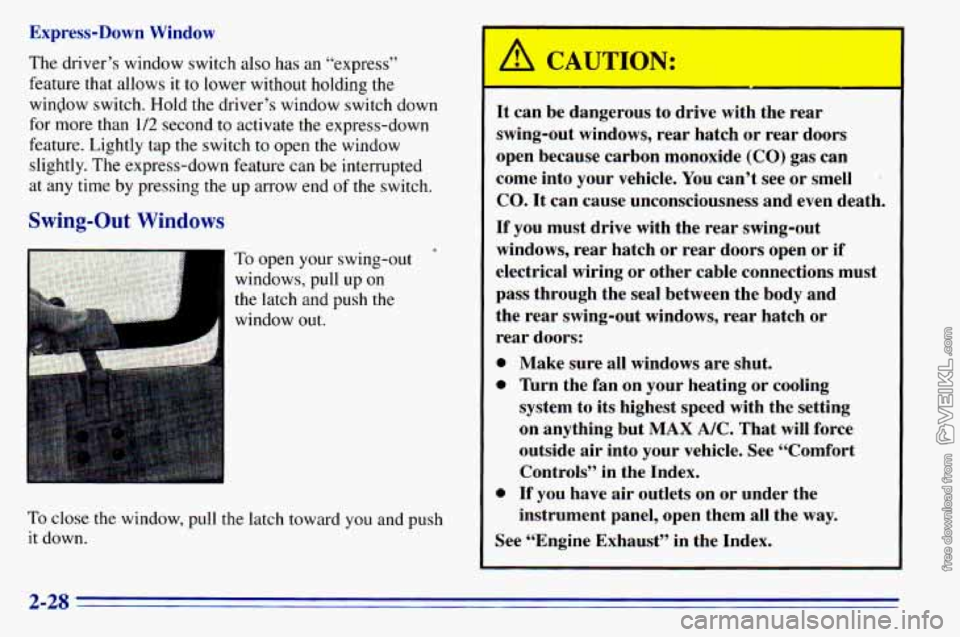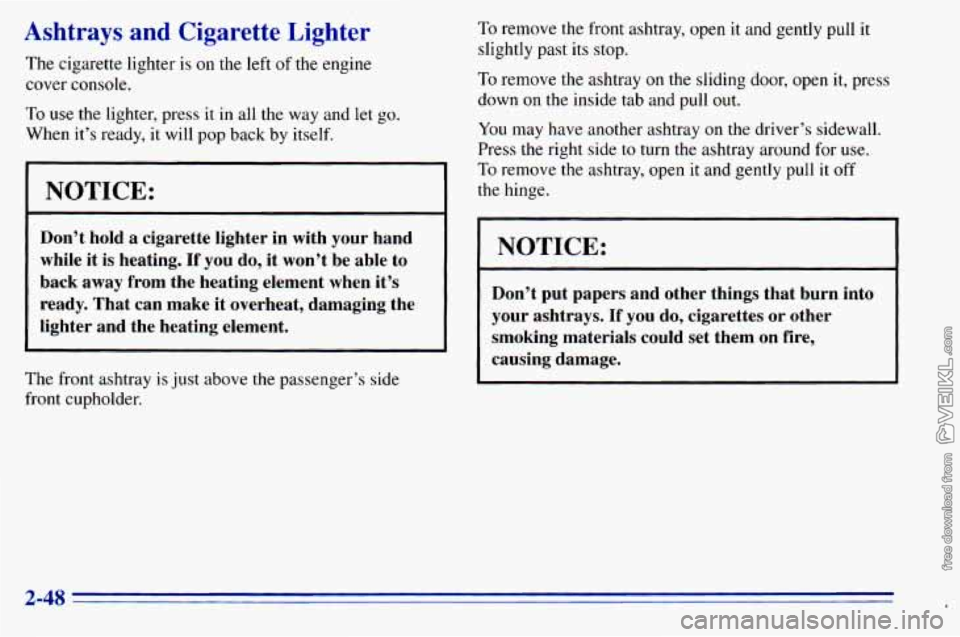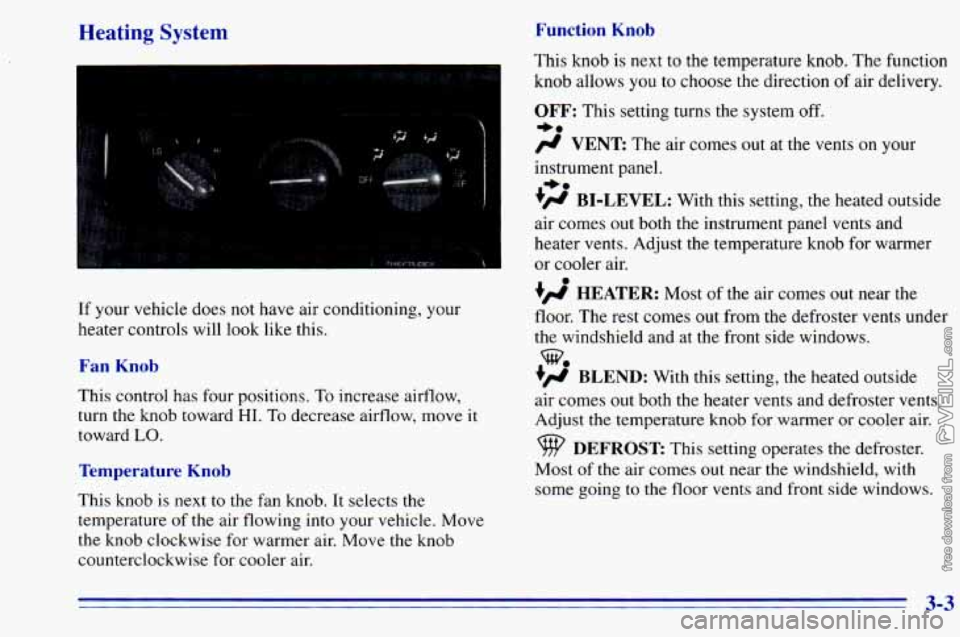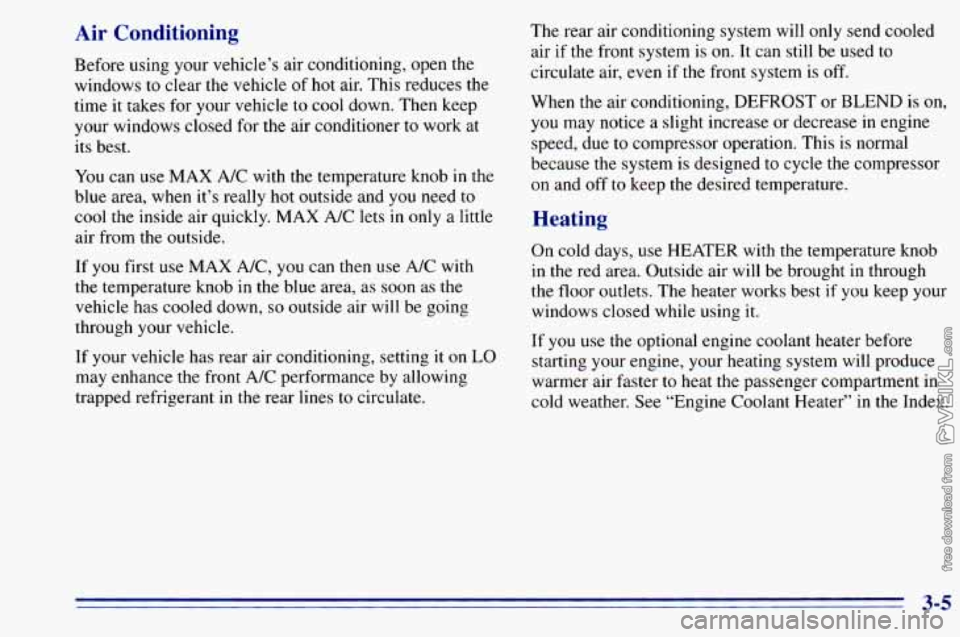Page 71 of 372

Hatch
A CAUTION:
It can be dangerous to drive with the rear
swing-out windows, rear hatch or rear doors
open because carbon monoxide (CO) gas can
come into your vehicle. You can’t see or smell
CO. It can cause unconsciousness and even death.
If you must drive with the rear swing-out
windows, rear hatch or rear doors open or
if
electrical wiring or other cable connections must
pass through the seal between the body and the
rear swing-out windows, rear hatch or rear doors:
Make sure all windows are shut.
’hrn the fan on your heating or cooling
system to its highest speed with the setting
on anything but MAX A/C. That will force
outside air into your vehicle. See “Comfort
Controls” in the Index.
instrument panel, open them all the way.
If you have air outlets on or under the
See “Engine Exhaust” in the Index.
Rear Hatch and Dutch Doors Release
(Option)
If you have this option, your vehicle must be in either
PARK (P) or NEUTRAL
(N) to release the hatch and
unlock the Dutch doors. If your battery
is dead, the
hatch and Dutch doors will not open,
even from the
outside with a key.
To release the hatch and
unlock the doors from the
inside of the vehicle, press
the REAR HATCH button
on the instrument panel.
It
is located on the right side of the steering column. The
hatch will release with or without the key
in the ignition.
Then, pull up on
the hatch handle and open the doors.
2-11
Page 88 of 372

Exprer- ’ wn Window
The driver
s window switch also has an “express”
feature that allows
it to lower without holding the
window switch. Hold the driver’s window switch down
for more than 112 second to activate the express-down
feature. Lightly tap the switch to open the window
slightly. The express-down feature can be interrupted
at any time by pressing the up arrow end of the switch.
Swing-Out Windows
‘D‘. : .,,: TO open your swing-out +
windows, pull up on
the latch and push the
window out.
e
It can be dangerous to drive with the rear
swing-out windows, rear hatch or rear doors
open because carbon monoxide
(CO) gas can
come into your vehicle. You can’t see or smell
*
CO. It can cause unconsciousness and even death.
If you must drive with the rear swing-out
windows, rear hatch or rear doors open or if
electrical wiring or other cable connections must
pass through the seal between the body and
the rear swing-out windows, rear hatch
or
rear doors:
TO close the window, pull the latch toward you and push
it down.
e
e Make sure all windows are shut.
”urn the fan on your heating or cooling
system to its highest speed with the setting
on anything but MAX
A/C. That will force
outside air into your vehicle. See “Comfort
Controls” in the Index.
If you have air outlets on or under the
instrument panel, open them all the way.
See “Engine Exhaust’’ in the Index.
2-28
Page 108 of 372

Ashtl- - ys and Cigarette Lighter
The cigarette lighter is on the left of the engine
cover console.
To use the lighter, press it in all the way and let go.
When it’s ready, it will pop back by itself.
NOTICE:
I
Don’t hold a cigarette lighter in with your hand
while it is heating,
If you do, it won’t be able to
back away from the heating element when it’s
ready. That can make it overheat, damaging the
lighter and the heating element.
The front ashtray is just above the passenger’s side
front cupholder.
To remove the front ashtray, open it and gently pull it
slightly past its stop.
To remove the ashtray on the sliding door, open it, press
down
on the inside tab and pull out.
You may have another ashtray
on the driver’s sidewall.
Press the right side to turn the ashtray around for use.
To remove the ashtray, open it and gently pull it off
the hinge.
I NOTICE:
Don’t put papers and other things that burn into
your ashtrays.
If you do, cigarettes or other
smoking materials could set them on fire,
causing damage.
2-48
Page 122 of 372
Engine Coolant Temperature Gage
If the gage pointer moves to
the red area, your engine is
too hot!
Daytime Running. Lamps, Indicator Light
:::O ..e
If your vehicle’was first
sold, when new, in Canada,
you will have this light on
the instrument panel.
It means that your engine coolant has overheated.
If you
have been operating your vehicle under normal driving
conditions, you should pull
off the road, stop your
vehicle and turn
off the engine as soon as possible. It goes
on whenever the Daytime Running Lamps (DRL)
are on. I
When it begins
to get dark, the DRL indicator light is a
reminder to
turn on your headlamps.
In “Problems on the Road,”
this manual shows you what
to do. See “Engine’Overheating” in the Index.
2-62
Page 125 of 372
Section 3 Comfort Controls and Audio Systems
I I
In this section you’ll find out how to operate the comfort
control and audio systems offered with your vehicle. Be
sure to read about the particular systems supplied with
your vehicle.
Comfort Controls
This section tells you how to make your air system work
for you. Your comfort control system uses ozone-friendly
R- 134a refrigerant.
With these systems,
you can control the heating, cooling
and ventilation
in your vehicle. Your vehicle also has
a flow-through ventilation system described later in
this section.
Heating/Air Conditioning System
If your vehicle has air conditioning, your heating/air
conditioning controls will
look like this.
3-1
Page 127 of 372

Heating System Function Knob
If your vehicle does not have air conditioning, your
heater controls will look like this.
Fan Knob
This control has four positions, To increase airflow,
turn the knob toward
HI. To decrease airflow, move it
toward
LO.
Temperature Knob
This knob is next to the fan knob. It selects the
temperature
of the air flowing into your vehicle. Move
the knob clockwise for warmer air. Move
the knob
counterclockwise for cooler air. This
knob is next to the temperature knob. The function
knob allows
you to choose the direction of air delivery.
OFF: This setting turns the system off.
-a
# VENT The air comes out at the vents on y r
instrument panel.
+# BI-LEVEL: With this setting, the heated outside
air comes out both the instrument panel vents and
heater vents. Adjust the temperature knob for warmer
or cooler air.
+’, HEATER: Most of the air comes out near the
floor. The rest comes out from the defroster vents under
the windshield and at the front side windows.
+’, BLEND: With this setting, the heated outside
air comes
out both the heater vents and defroster vents.
Adjust
the temperature knob for warmer or cooler air.
+.
%
DEFROST This setting operates the defroster.
Most
of the air comes out near the windshield, with
some going to the floor vents and front side windows.
3-3
Page 128 of 372
Rear Heating System (Option) Rear Air Conditioning System (Option)
You may have the optional rear heater. The three-speed
fan switch is
to the right of the radio. Turn the switch
toward
HIGH for higher airflow in the rear area. Turn
the switch to the
OFF position to turn the system off.
You may have rear air conditioning. The rear air
conditioning switch is located to
the right of the heater
controls. Turn the switch toward
HIGH for higher
airflow
in the rear area. Turn the switch to the OFF
position to turn the system off.
3-4
Page 129 of 372

Air Conditioning
Before using your vehicle’s air conditioning, open the
windows to clear the vehicle of hot air. This reduces the
time it takes for your vehicle to cool down. Then keep
your windows closed for the air conditioner to work at
its best.
You can use MAX A/C with the temperature knob in the
blue area, when it’s really hot outside and you need to
cool the inside air quickly. MAX A/C lets
in only a little
air from the outside.
If you first use MAX A/C, you can then use A/C
with
the temperature knob in the blue area, as soon as the
vehicle has cooled down,
so outside air will be going
through your vehicle.
If your vehicle has rear air conditioning, setting
it on LO
may enhance the front A/C performance by allowing
trapped refrigerant in the rear lines to circulate. The
rear air conditioning system will only send cooled
air if the front system is on. It can still be used to
circulate air, even if the front system is off.
When the air conditioning, DEFROST or BLEND is on,
you may notice a slight increase or decrease
in engine
speed, due to compressor operation. This is normal
because
the system is designed to cycle the compressor
on and off to keep the desired temperature.
Heating
On cold days, use HEATER with the temperature knob
in the red area. Outside air will be brought in through
the floor outlets. The heater works best
if you keep your
windows closed while using it.
If you use the optional engine coolant heater before
starting your engine, your heating system will produce
warmer air faster to heat the passenger compartment in
cold weather. See “Engine Coolant Heater”
in the Index.
3-5